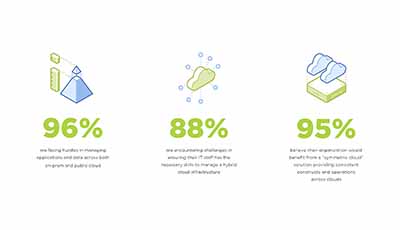
Nutanix announced findings of a new report analyzing key challenges and opportunities with hybrid cloud adoption. While most see hybrid cloud as the ideal IT model, the report showed that many struggle to adopt it — with 70% of organizations believing that their transformation is taking longer than expected. However, the goal is clear: nearly all respondents (95%) think their organization would benefit from an optimal hybrid implementation providing consistent IT constructs and operations across multiple clouds, eliminating many of the challenges they currently face ranging from operational silos to staffing shortages.
As businesses everywhere struggle to adapt to a new reality, one thing is becoming even clearer: flexibility is crucial to business success. Whether enterprises need to leverage public cloud to deliver remote desktops quickly, consolidate disaster recovery sites, move workloads to a private cloud to stave off public cloud capacity concerns, or take advantage of on-demand capacity bursting, the current global situation has emphasized the need for an adaptable IT infrastructure for many businesses. But flexibility no longer means using both public and private clouds — it means having a consistent experience, tooling, and operational practices across multiple clouds to dramatically simplify the ability to move applications and data to the most appropriate cloud environment.
“Today, modern organizations need to lead with flexibility, and a critical aspect of this is decentralizing resources to make them more readily available,” said Aaron White, Regional Sales Director – Middle East at Nutanix. “By using multiple clouds, whether public, private, or at the edge, businesses can simply bring their IT infrastructure where it is most needed. But, as we saw in the research, this flexibility is only possible with consistent constructs, operations and tooling across multiple clouds, making a hybrid cloud environment ideal.”

The report, commissioned by Nutanix and created by independent market research firm Vanson Bourne, analyzed key challenges businesses are currently facing when managing both public and private cloud infrastructures. The company surveyed 650 IT decision-makers from multiple industries, business sizes and geographies in the Americas; Europe, the Middle East, Africa (EMEA); and Asia-Pacific and Japan (APJ) regions.
Additional findings include:
Businesses are looking for flexibility. It’s no longer a choice between private and public, or between different public cloud providers. Organizations need a solution providing a consistent experience, tooling, and operational practices across multiple clouds to address many of the challenges and operational inefficiencies they’re currently facing. An optimal hybrid cloud environment provides the consistency they need to take advantage of the full flexibility of multiple clouds, whether private or public.
Nutanix announced findings of a new report analyzing key challenges and opportunities with hybrid cloud adoption. While most see hybrid cloud as the ideal IT model, the report showed that many struggle to adopt it — with 70% of organizations believing that their transformation is taking longer than expected. However, the goal is clear: nearly all respondents (95%) think their organization would benefit from an optimal hybrid implementation providing consistent IT constructs and operations across multiple clouds, eliminating many of the challenges they currently face ranging from operational silos to staffing shortages.
As businesses everywhere struggle to adapt to a new reality, one thing is becoming even clearer: flexibility is crucial to business success. Whether enterprises need to leverage public cloud to deliver remote desktops quickly, consolidate disaster recovery sites, move workloads to a private cloud to stave off public cloud capacity concerns, or take advantage of on-demand capacity bursting, the current global situation has emphasized the need for an adaptable IT infrastructure for many businesses. But flexibility no longer means using both public and private clouds — it means having a consistent experience, tooling, and operational practices across multiple clouds to dramatically simplify the ability to move applications and data to the most appropriate cloud environment.
“Today, modern organizations need to lead with flexibility, and a critical aspect of this is decentralizing resources to make them more readily available,” said Aaron White, Regional Sales Director – Middle East at Nutanix. “By using multiple clouds, whether public, private, or at the edge, businesses can simply bring their IT infrastructure where it is most needed. But, as we saw in the research, this flexibility is only possible with consistent constructs, operations and tooling across multiple clouds, making a hybrid cloud environment ideal.”
The report, commissioned by Nutanix and created by independent market research firm Vanson Bourne, analyzed key challenges businesses are currently facing when managing both public and private cloud infrastructures. The company surveyed 650 IT decision-makers from multiple industries, business sizes, and geographies in the Americas; Europe, the Middle East, Africa (EMEA); and Asia-Pacific and Japan (APJ) regions.
Additional findings include:
Businesses are looking for flexibility. It’s no longer a choice between private and public, or between different public cloud providers. Organizations need a solution providing a consistent experience, tooling, and operational practices across multiple clouds to address many of the challenges and operational inefficiencies they’re currently facing. An optimal hybrid cloud environment provides the consistency they need to take advantage of the full flexibility of multiple clouds, whether private or public.